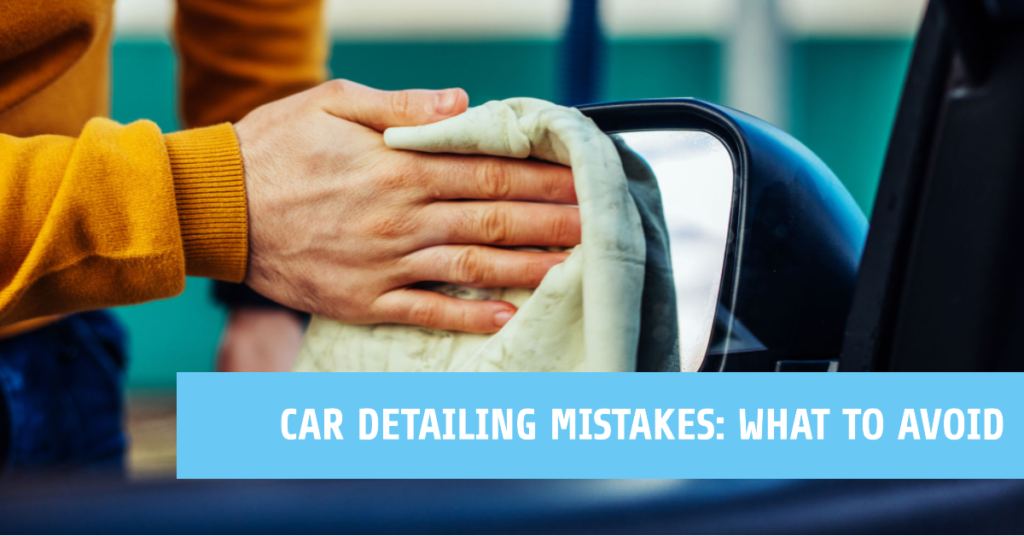
Car detailing is essential for keeping your vehicle in top condition. However, beginners often make mistakes that can harm their car’s appearance and value. In this guide, we’ll cover common errors and how to avoid them. By the end, you’ll have the knowledge to confidently detail your car like a pro. Remember to visit our essential car detailing tools and products page for the right equipment.
Mistake #1: Using the Wrong Tools and Products
Using the correct tools and products is critical for successful car detailing. Unfortunately, many beginners select inappropriate items that can damage their vehicle.
Importance of Proper Tools and Products
The right tools and products protect your car’s surfaces, reduce the risk of damage, and provide optimal results. Using unsuitable items can cause scratches, swirl marks, and other issues.
Common Errors in Tool and Product Selection
- Using household cleaning products: Automotive-specific cleaners are formulated to safely remove dirt and grime without damaging your car’s finish.
- Applying abrasive materials: Avoid using rough sponges, brushes, or towels. Instead, opt for microfiber towels to prevent scratches.
- Selecting low-quality waxes and sealants: High-quality products provide better protection, shine, and durability.
Tips for Choosing the Right Tools and Products
- Research and read reviews to find top-rated detailing products.
- Stick to car detailing kits designed for your vehicle type.
- Consult our car detailing tools and products guide for recommendations.
Mistake #2: Not Following a Proper Order for Detailing Tasks
Organizing your detailing tasks in the correct order maximizes efficiency and prevents rework.
The Correct Order for Detailing Tasks
- Pre-rinse and wash the exterior.
- Clean wheels and tires.
- Apply clay bar treatment if needed.
- Polish and apply protective coatings or wax.
- Clean the windows and mirrors.
- Detail the interior, including vacuuming, wiping down surfaces, and cleaning upholstery.
The Impact of Completing Tasks Out of Order
Performing tasks out of order can lead to cross-contamination, causing damage to your car’s surfaces. Additionally, it may result in extra work, as you may have to redo certain steps.
Tips for Developing an Effective Detailing Routine
- Plan your detailing session in advance.
- Allocate sufficient time for each task.
- Maintain a consistent process to build good habits.
Mistake #3: Applying Too Much Pressure When Cleaning
Excessive pressure during cleaning can damage your car’s surfaces. Learn the proper techniques to avoid harm.
Risks of Using Excessive Pressure
Applying too much force while cleaning can cause scratches, swirl marks, and other surface damage. It can also lead to uneven product application or removal.
Proper Pressure Application Techniques
- Use gentle, even pressure while cleaning your car’s exterior and interior surfaces.
- When applying cleaners, waxes, or polishes, work in small, circular motions to distribute the product evenly.
- When removing products, use light pressure and let the microfiber towel do the work.
Tips for Avoiding Damage from Excessive Pressure
- Choose soft, high-quality cleaning tools, such as microfiber towels.
- Be patient and take your time when cleaning and detailing your car.
- Regularly inspect your cleaning tools for debris that could scratch your vehicle’s surfaces.
Mistake #4: Ignoring Proper Drying Techniques
Drying your car correctly is essential for preventing water spots and maintaining a pristine finish.
Risks of Improper Drying
Failing to dry your car properly can result in water spots, streaks, and mineral deposits on your vehicle’s surfaces. Additionally, excess moisture may promote mold and mildew growth in your car’s interior.
Proper Drying Techniques
- Use a high-quality, absorbent microfiber drying towel or waffle weave towel to remove water from your car’s surface.
- Start at the top of your car and work your way down to avoid water running onto already-dried areas.
- Dry your car immediately after washing to prevent water spots from forming.
Tips for Effective Drying
- Consider using a car-specific drying aid to help prevent water spots and improve drying efficiency.
- Make sure to dry door jambs, trunk edges, and other areas where water may collect.
- Be gentle when drying to avoid accidentally scratching your car’s surfaces.
Mistake #5: Neglecting Hard-to-Reach Areas
- When detailing a car, it’s easy to overlook small, hard-to-reach areas. However, neglecting these spots can lead to a buildup of dirt, grime, and bacteria, negatively impacting your car’s appearance and cleanliness.
Risks of Overlooking Hard-to-Reach Areas
Allowing dirt and grime to accumulate in hidden spots can cause corrosion, odors, and an overall decline in your car’s condition. It also detracts from the thoroughness and quality of your detailing job.
Techniques for Cleaning Hard-to-Reach Areas
- Use specialized detailing brushes to clean tight spaces, such as air vents, seams, and crevices.
- Address areas like door jambs, the engine bay, and undercarriage during your detailing process.
- Remove and clean floor mats, as well as any removable interior components, to access hidden dirt and grime.
Tips for Ensuring Comprehensive Detailing
- Develop a checklist to remind you to clean all areas of your car, including those that are easily overlooked.
- Invest in a variety of detailing brushes and tools designed for hard-to-reach spots.
- Regularly inspect your car for hidden dirt, paying special attention to areas that may trap moisture.
Mistake #6: Skipping Proper Protection and Maintenance
- After investing time and effort into detailing your car, it’s essential to maintain and protect your work. Skipping these steps can lead to premature wear and tear on your vehicle.
Risks of Neglecting Protection and Maintenance
- Without proper protection, your car’s surfaces are more susceptible to damage from UV rays, environmental contaminants, and general wear and tear. Regular maintenance ensures that your detailing efforts are long-lasting and effective.
Protection and Maintenance Techniques
- Apply high-quality waxes, sealants, or ceramic coatings to protect your car’s paint and exterior surfaces.
- Treat your interior surfaces with appropriate protectants, such as UV-blocking agents for your dashboard or leather conditioners for leather upholstery.
- Regularly inspect and clean your car to maintain its appearance and prevent damage.
Tips for Effective Protection and Maintenance
- Set up a routine maintenance schedule to help preserve your car’s detailed condition.
- Choose protective products that are specifically designed for your car’s surfaces and materials.
- Store your car in a garage or use a car cover to shield it from harsh environmental elements.
By avoiding these common detailing mistakes and implementing the suggested solutions, you’ll be well-equipped to detail your car like a pro. With practice and dedication, you’ll soon master the art of car detailing and keep your vehicle looking its best. Don’t forget to visit our essential car detailing tools and products page for the right equipment and recommendations to support your detailing journey.
